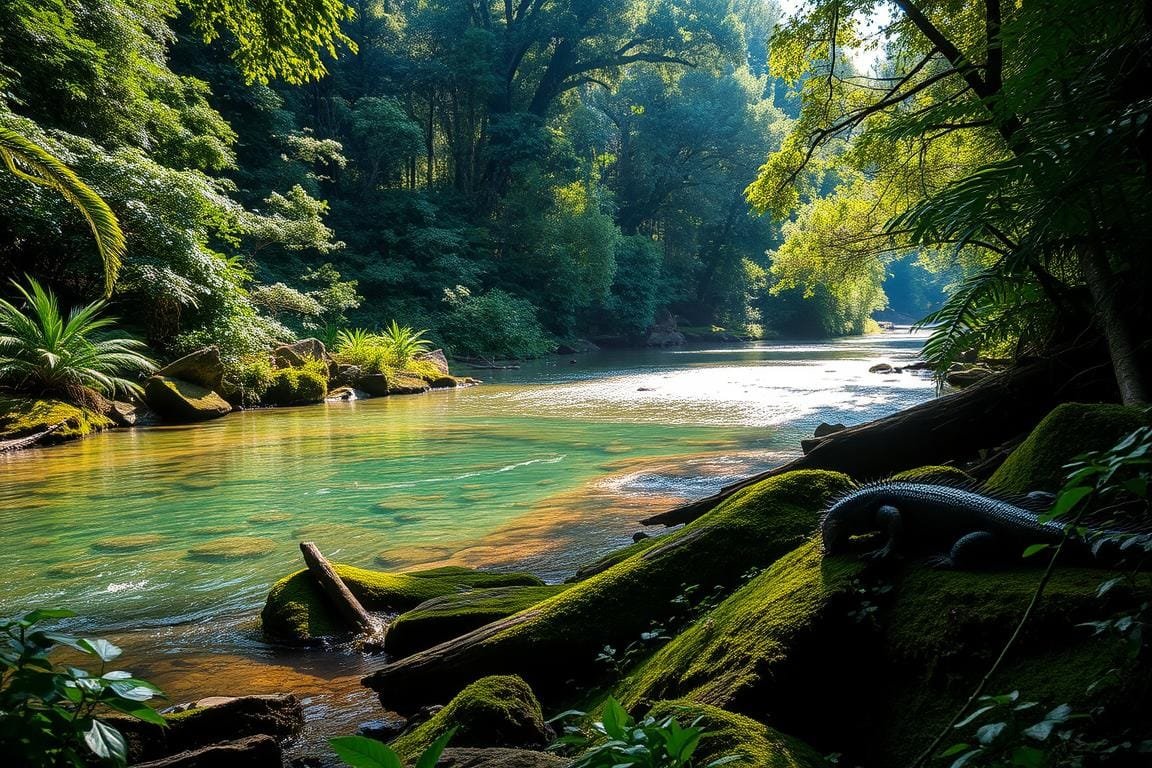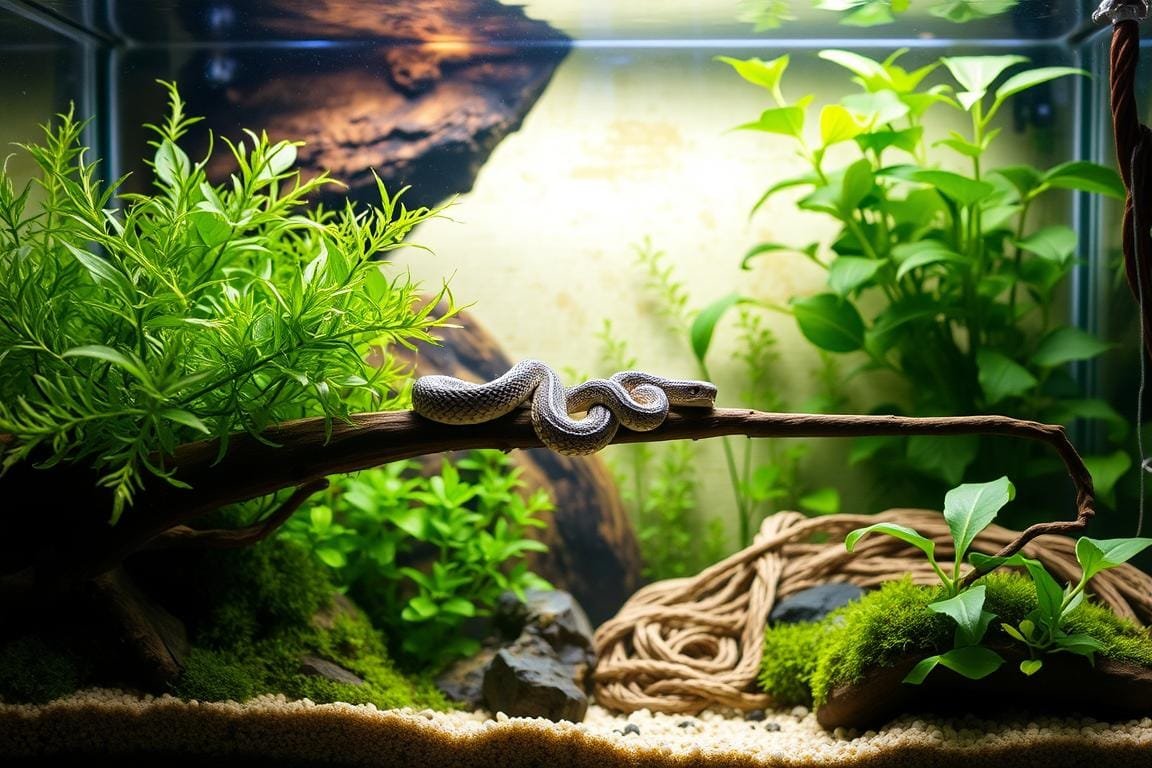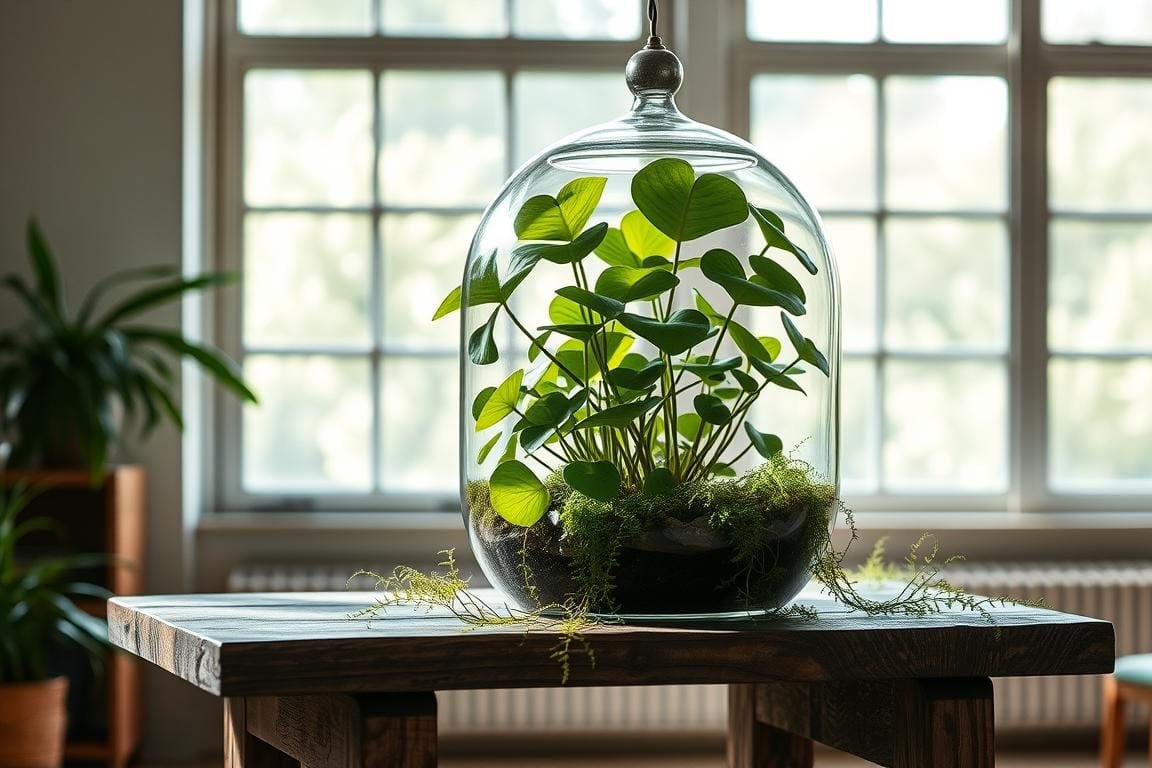Designing a habitat for your Australian water dragon requires careful planning. These reptiles thrive in environments that mirror their natural habitats. By focusing on heat, light, and space, you can create a setup that keeps them healthy and active.
Mimicking wild conditions is essential. Proper heating zones and UVB lighting help regulate body temperature and support bone health. A mix of basking spots and shaded areas ensures your pet can self-regulate comfort.
Size matters for these agile climbers. Tall enclosures with branches and plants allow them to explore vertically. Secure hiding spots reduce stress, making them feel safe in their space.
Don’t forget hydration! Shallow pools or misting systems maintain humidity levels. Pairing water features with dry land mimics the riverside ecosystems they love. This balance sets the foundation for a thriving habitat.
Ready to dive deeper? Let’s explore how to tailor every detail—from temperature gradients to enrichment—for your scaled companion’s happiness.
Understanding Eastern Water Dragon Needs
Australian water dragons flourish when their living space mirrors their native ecosystems. These agile reptiles originate from forested regions near streams, where they split time between climbing trees and swimming. Observing their wild routines helps craft habitats that keep them mentally stimulated and physically healthy.
Natural Habitat and Behavior
In the wild, these lizards inhabit areas dense with vegetation and access to shallow waterways. They’re expert climbers, often seen basking on branches 6-10 feet above ground. Daylight hours involve alternating between sun-soaked perches and quick dips to regulate body temperature.
Younger specimens tend to stay closer to water sources for safety. Adults establish territories with multiple basking spots and hiding places. This behavior highlights the need for vertical space and varied terrain in captivity.
Key Environmental Requirements
A proper setup balances airflow and moisture control. Screen-topped enclosures prevent stagnant air while maintaining 60-80% humidity. Strategic placement of heat lamps creates warm zones (95°F) and cooler retreats (75°F).
| Feature | Juveniles | Fully Grown |
|---|---|---|
| Enclosure Size | 30-40 gallons | 120+ gallons |
| Basking Spot Height | 12 inches | 18-24 inches |
| Humidity Range | 70-80% | 60-70% |
| Climbing Structures | Thin branches | Sturdy logs |
Live plants like pothos or bromeliads boost humidity naturally. Combine these with flat rocks under heat sources to mimic sun-warmed surfaces from their native environment. Regular misting supports hydration and skin health during shedding cycles.
Planning Your Eastern Water Dragon Enclosure Design
Crafting a comfortable home for your scaly friend starts with smart space planning. Divide the habitat into three zones: a warm end for heat absorption, a middle activity area, and a cooler retreat. This setup lets your pet regulate its body temperature naturally.
Setting a Realistic Layout and Space Allocation
Begin by sketching your enclosure’s floor plan. Reserve 30% of the space for a dedicated basking spot under UVB lights. Position heat lamps at one end to create a 95°F zone, gradually cooling to 75°F on the opposite side. Use flat rocks or driftwood as raised platforms near the warmth source.
Leave ample room between climbing branches and water features. Overcrowding limits movement and increases stress. Pro tip: Test the layout with temporary decor before finalizing placements.
Incorporating Both Basking and Water Areas
Balance is crucial. Install a water basin deep enough for submersion but shallow enough for easy exits. Pair it with elevated, non-slip surfaces for drying off. Make sure the basking area stays completely dry to prevent bacterial growth.
Add hiding spots near the cooler side using hollow logs or plant clusters. This contrast between open basking zones and sheltered nooks mirrors wild environments. Regularly check temperature gradients with digital thermometers to maintain ideal conditions.
Choosing the Right Enclosure Size and Layout
Creating a habitat that supports your reptile’s growth starts with smart spatial planning. Young lizards need room to explore safely, while adults require generous vertical and horizontal space. Let’s break down how to balance these needs effectively.
Minimum Space Requirements and Guidelines
Authorities like the Association of Reptile Keepers recommend enclosures measuring at least 4ft (L) x 2ft (W) x 4ft (H) for adults. Juveniles thrive in smaller 30-gallon tanks but need upgrades every 6-8 months. Vertical space matters most—these climbers use height for exercise and stress reduction.
| Feature | Juveniles | Adults |
|---|---|---|
| Floor Area | 18″ x 12″ | 48″ x 24″ |
| Vertical Height | 18″ | 48″ |
| Branch Diameter | 1-2″ | 3-4″ |
| Water Zone Size | 6″ x 8″ | 18″ x 12″ |
Optimizing Floor Area for Comfort
Arrange decor to create “activity highways.” Position thick branches diagonally across the space, connecting basking zones to hiding spots. Leave 40% of floor space open for movement. Use live plants like ficus trees to add climbing opportunities without crowding.
Adjust layouts as your pet grows. Swap slim perches for sturdier ones once they reach 12″ in length. Expand water features gradually to match their swimming confidence. A well-planned habitat grows with your reptile’s needs.
Temperature and Heating Requirements

Heat management forms the backbone of a thriving habitat for active lizards. Without proper thermal zones, your pet can’t digest insects effectively or absorb nutrients from their diet. Let’s break down how to create a safe, efficient heating system.
Establishing a Temperature Gradient
Reptiles rely on external heat sources to regulate their body temperature. Aim for a 95°F basking zone at one end, tapering to 75°F on the cooler side. Use a 100-150 watt basking bulb positioned 12-18 inches above a flat rock or branch.
Digital thermometers at both ends help track this gradient. Pro tip: Place hides in transitional areas so your pet can adjust comfortably. Consistent warmth supports metabolism, especially when digesting protein-rich foods like crickets or mealworms.
Proper Usage of Basking Lamps and Ceramic Heaters
Basking lamps should mimic natural sunlight cycles—on for 10-12 hours daily. Pair them with ceramic heat emitters for nighttime warmth without light disruption. These devices maintain ambient temperatures around 80°F after dark.
| Heating Tool | Daytime Use | Nighttime Use | Key Benefit |
|---|---|---|---|
| Basking Lamp | 95°F | Off | Stimulates activity |
| Ceramic Heater | Optional | 80°F | Gentle warmth |
Monitor closely—overheating can reduce appetite for insects and greens. For detailed guidance, consult this comprehensive care guide. Proper heat ensures your reptile maximizes nutrients from every diet, whether it’s mealworms or leafy veggies.
Integrating Optimal UVB Lighting
Proper UVB lighting isn’t just an accessory—it’s a lifeline for your reptile’s health. Without it, calcium metabolism falters, leading to brittle bones and muscle weakness. Smart bulb selection and placement ensure your pet absorbs nutrients effectively over time.
Selecting Suitable UVB Bulbs
T5 HO bulbs outperform T8 models, emitting stronger UVB rays up to 18 inches away. These last 12-14 months, while T8s dim after 6-8 months. Match bulb strength to your setup’s height for safe, effective exposure.
| Bulb Type | Effective Range | Lifespan | Best For |
|---|---|---|---|
| T5 HO 10.0 | 12-18″ | 12 months | Tall habitats |
| T8 10.0 | 6-8″ | 6 months | Compact setups |
Creating a UV Gradient for Effective Exposure
Position the UVB fixture across ⅓ of the habitat’s length. This creates zones from intense basking light to shaded areas. Rotate basking branches every few days to prevent uneven wear.
Use timers for 10-12 daylight hours daily. Replace bulbs every 6-12 months—even if they still glow. UV output drops long before the bulb dies. Consistent cycles mimic natural patterns, keeping your pet thriving for years.
Establishing Humidity and Substrate Solutions

Creating the ideal living space for your scaly companion involves more than just heat and light. The right substrate and moisture balance play starring roles in their health. Let’s explore how to build a foundation that keeps your pet thriving.
Choosing Absorptive and Moisture-Retaining Substrates
Substrate choice directly impacts humidity levels for this species. Cypress mulch works wonders—it holds moisture without molding quickly. Coconut fiber blends are another favorite, offering natural texture for digging.
Soil-and-sphagnum moss mixes mimic forest floors. These retain water while allowing airflow. Avoid sand or gravel—they dry out fast and can harm your lizard if ingested.
| Substrate Type | Moisture Retention | Safety | Best For |
|---|---|---|---|
| Cypress Mulch | High | Non-toxic | Adult reptiles |
| Coconut Fiber | Medium-High | Digestible | Juveniles |
| Soil/Moss Mix | Adjustable | Natural | All life stages |
Enhancing Humidity Naturally
Live plants like pothos or snake plants boost moisture through transpiration. Place their pots near heat sources to create gentle steam. Daily misting adds hydration without waterlogging the substrate.
Shallow water dishes double as drinking spots and humidity boosters. Replace 25% of the substrate weekly to prevent bacteria buildup. This keeps conditions fresh for your active reptile.
Balance is key—too much moisture breeds mold, while too little causes shedding issues. Pair humidity checks with temperature monitoring to keep your species comfortable year-round.
Designing a Functional Basking and Water Area
Balancing warmth and moisture zones creates a habitat where your reptile thrives. Properly arranged heat and humidity areas support natural behaviors like thermoregulation and hydration. Let’s explore how to build these essential spaces for daily care.
Creating the Perfect Sunlit Lounge
Position basking platforms 8-12 inches below heat lamps. Use slate tiles or driftwood—materials that retain warmth. Pair this zone with UVB bulbs to maximize nutrient absorption. A 100-watt bulb typically maintains 95°F surface temps.
Include multiple perch heights. This lets your pet choose ideal exposure levels. Check temperatures daily with infrared thermometers. Adjust lamp height if surfaces exceed 100°F.
Building a Refreshing Oasis
Water features should allow full-body submersion. For adults, aim for 6-8 inch depths. Add ramps or textured rocks for easy entry/exit. Change water every 48 hours to prevent bacterial growth.
| Feature | Basking Zone | Water Area |
|---|---|---|
| Ideal Temperature | 95°F | 75-80°F |
| Key Equipment | Ceramic heat emitter | Submersible heater |
| Maintenance Frequency | Weekly bulb checks | Daily water changes |
Place the water basin near the habitat’s cooler side. This setup mimics natural riverside environments. Use a hygrometer to track humidity between 60-70%—critical for healthy shedding.
Rotate decor monthly to maintain interest. Combine these requirements with consistent care routines, and your scaled friend will enjoy both comfort and stimulation.
Incorporating Natural Decorations and Climbing Features
Natural decorations transform sterile spaces into engaging habitats. Strategically placed branches, rocks, and plants reduce stress while encouraging natural behaviors. These elements also help pets feel secure, making their environment both functional and visually appealing.
Smart Use of Branches and Rocks
Choose untreated hardwood branches for climbing structures. Position them diagonally to create vertical pathways. Anchor large rocks securely to prevent shifting—this protects the substrate layer below. For inspiration, explore these decorating tips using native Australian plants.
| Natural Element | Functional Benefit | Safety Tip |
|---|---|---|
| Mopani Wood | Durable climbing surface | Boil before use |
| Slate Tiles | Retains basking heat | Sand sharp edges |
| Cork Rounds | Multi-level hiding spots | Check for mold weekly |
Creating Safe Retreats
Hiding areas should accommodate your reptile’s full body length. Use hollow logs or stacked flat stones near cooler zones. Elevate some shelters on platforms to mimic tree hollows found in wild habitats.
Maintain substrate stability by placing heavy decor directly on enclosure floors. Add a 1-inch gravel base under climbing structures for extra support. This prevents collapses that could stress your pets.
Live plants like snake plants or bromeliads boost humidity naturally. Pair them with artificial vines for year-round greenery. These touches make enclosures beautiful while supporting physical and mental health.
Ensuring Proper Feeding and Diet Zones
Feeding your reptile companion goes beyond just offering food—it’s about creating a balanced ecosystem within their habitat. Dedicated feeding zones prevent messes and support natural hunting instincts. This approach keeps meals stress-free while maintaining clean water sources for hydration.
Arranging Feeding Areas for Live Insects
Set up a dry platform away from the hydration zone for serving live prey. Use shallow dishes or flat rocks to contain crickets and mealworms. Juveniles need daily feedings, while adults thrive on meals every 2-3 days.
| Age | Frequency | Portion Size |
|---|---|---|
| Hatchlings | 2x daily | 5-8 insects |
| Adults | 4x weekly | 10-15 insects |
Rotate feeding spots to avoid leftover debris. Pro tip: Dust insects with calcium powder before release to boost nutrient intake.
Supplementing With Nutrient-Rich Foods
While live prey forms the diet’s core, add variety with leafy greens and fruits. Collard greens and blueberries provide vitamins missing in captive diets. Always chop produce into bite-sized pieces.
- Calcium powder: Dust prey 3x weekly
- Multivitamins: Add once every 10 days
- Fresh veggies: Offer daily as side dishes
When keeping Australian water dragons, ensure their hydration zone stays separate from feeding areas. Change drinking water daily to prevent bacterial growth—a critical step for reptiles that spend a lot of time soaking.
Maintenance, Cleaning, and Safety Considerations
A clean habitat is vital for your reptile’s health and happiness. Regular upkeep prevents harmful bacteria and keeps your pet active. Let’s explore how to balance efficiency with thoroughness in your care routine.
Establishing a Regular Cleaning Routine
Start by relocating your pet to a temporary space. Use a small carrier lined with paper towels. This reduces stress during the cleaning process.
Remove all decorations and substrates weekly. Scrub surfaces with a reptile-safe disinfectant. Rinse thoroughly to eliminate chemical residues.
| Task | Frequency | Tools Needed |
|---|---|---|
| Water bowl cleaning | Daily | Vinegar solution |
| Substrate replacement | Bi-weekly | Gloves, scooper |
| Full habitat deep-clean | Monthly | Steam cleaner |
Keeping the Enclosure Safe and Hygienic
Check for sharp edges on branches or rocks. File down rough spots to prevent cuts. Australian water dragons often rub against surfaces during shedding.
Use a hygrometer to monitor humidity spikes. Excess moisture encourages mold growth—a common issue for Chinese water dragon habitats. Improve airflow with adjustable vents if needed.
Dispose of waste promptly using tongs. Spot-clean daily between full maintenance sessions. This approach keeps environments fresh without overwhelming effort.
Wrapping Up Your Dream Enclosure
Building a thriving home for your scaly companion combines science and creativity. Every detail—from cozy basking spots to climbing structures—supports their natural behaviors. Proper heating zones, UVB lighting, and spacious layouts let these animals thrive just like in the wild.
Remember to prioritize vertical space. Tall habitats with branches stretching several feet upward encourage climbing and exploration. Pair this with a shallow pool for soaking and hydration needs. Natural decor like flat rocks or cork bark helps them feel secure while showing off their vibrant tail patterns.
Double-check your setup against this guide. Did you leave enough room between decor items? Is the temperature gradient consistent? A lot goes into creating environments where active reptiles stay healthy and engaged.
Your effort pays off when you see your pet basking confidently or darting across their habitat. Use these tips as a checklist to craft a space that exceeds basic needs—a true sanctuary tailored to their instincts.





